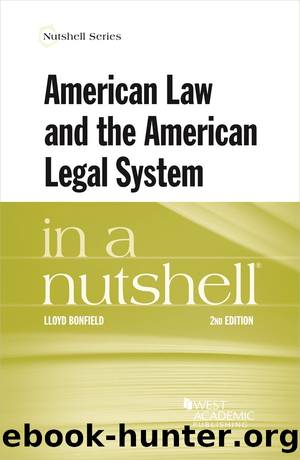American Law and the American Legal System in a Nutshell by Lloyd Bonfield

Author:Lloyd Bonfield
Language: eng
Format: epub
ISBN: 9781634606455
Publisher: West Academic Publishing
Published: 2020-10-15T00:00:00+00:00
Copyright
Copyright protects âworks of authorship,â creative expression in almost any medium. While literary works, novels, plays, poems, and even academic writings like this Nutshell, spring immediately to mind, copyright protection has been extended to almost all art forms including the visual, and to recordings, computer programs, and even architectural works. Copyright protects forms of expression; facts or ideas themselves are not protected, but their expression may be, for example, reducing your unwritten lyrics to a recorded studio album. Likewise, copyright extends only to original and creative works. Mere work product is not always protected; for example, the compiling of the phonebookâs yellow pages cannot be copyrighted, because it lacks the so-called âcreative sparkâ that is necessary for the expression to promote the useful arts.
Moreover, as technology advances, questions have arisen as to who exactly qualifies as an author; does a work produced by artificial intelligence qualify for federal copyright protection, or is protection limited strictly to works produced by the human mind? See Sarah Ligon, AI Can Create Art, but Can It Own Copyright in It, or Infringe?, The Lexis Nexis Practice Advisor Journal (Jan. 2, 2019), https://âwww.âlexisnexis.com/lexis-practice-advisor/the-214
journalâ/âb/lpa/posts/ai-can-create-art-but-can-it-own-copyright-in-it-or-infringe. The Copyright Act itself does not so expressly define âauthorshipâ (but it does suggest that the author be human by defining âanonymous workâ as one in which âno natural person is identified as author,â and by making reference to an authorâs widow). 17 U.S.C.S. § 101 (LEXIS through Pub. L. 116â155). The U.S. Copyright Office has also not plainly addressed the issue, but it has rejected as copyrightable âworks produced by a . . . mere mechanical process.â U.S. COPYRIGHT OFFICE, COMPENDIUM OF U.S. COPYRIGHT OFFICE PRACTICES § 101 (3d ed. 2017).
Copyright right protection commences at creation, and strictly speaking, filing is unnecessary (though it is prudent to do so because it creates a public record of the work and substantiates the claim of copyright). The term was extended by Congress (and the Act upheld by the Supreme Court in Eldred v. Ashcroft, 537 U.S. 186 (2003)) to seventy years after the authorâs death for works produced after 1977. 17 U.S.C.S. § 101. Works created earlier have a ninety-five-year term, as do âworks for hire,â those which are produced by employees in the course of their duties, with the intellectual property owned by the employer. The author or owner of the copyrighted material has the exclusive right during the period to exploit the work, including the right to reproduce it, make copies, prepare derivative works, or in the case of visual works, perform it or arrange for its display. Further protection is accorded to visual artists under the Visual Artists Rights Act, which accords artists 215
rights similar to (though perhaps not as extensive as) the moral right of artists in European Union law. 17 U.S.C.S. § 106A (LEXIS through Pub. L. 116â155).
Even during the copyright period, the public may make some, albeit limited, use of the copyrighted material. For example, others are permitted âfair useâ of the copyrighted material during the copyright period.
Download
This site does not store any files on its server. We only index and link to content provided by other sites. Please contact the content providers to delete copyright contents if any and email us, we'll remove relevant links or contents immediately.
